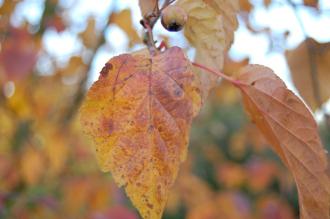
Malus yunnanensis veitchii (18/11/2012, Kew Gardens, London)
Position: Full sun
Flowering period: Late spring
Soil: Moist, well drained
Eventual Height: 10m
Eventual Spread: 7m
Hardiness: 6a – 9a
Family: Rosaceae
Malus yunnanensis veitchii is a deciduous tree with an upright habit. Its mid green leaves are opposite, ovate with double serrate margins, up to 10cm long and 5cm broad. Its leaves turn orange/ red in autumn before they fall. Its branches are ascending. Its white flowers are five petaled and arranged in corymbs. Its red fruit are pomes and develop thorough the summer months.
Malus yunnanensis veitchii, commonly known as Chuan E Dian Chi Hai Tang, is native to central China. This tree does not suffer from mildew or scab. It was discovered in 1923 by Alfred Rehder (1863 – 1949), an American horticulturalist.
The etymological root of the binomial name Malus is the ancient Latin name for the apple tree. Yunnanensis is derived from the Latin meaning ‘from Yunnan, China’. Veitchii is named after the Veitch family, a family of eminent horticulturalists which spanned the 18th, 19th and 20th Centuries.
The landscape architect may find Malus yunnanensis veitchii useful as a small specimen tree.
Ecologically, Malus yunnanensis veitchii flowers are attractive to pollinating insects. Its fruit are attractive to birds and some mammals.

Malus yunnanensis veitchii Autumn Leaf (18/11/2012, Kew Gardens, London)
Malus yunnanensis veitchii prefers moist, fertile, well-drained soils. It tolerates most pH of soil.
Malus yunnanensis veitchii requires little maintenance.

